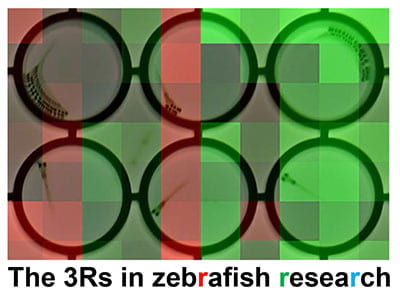
February 28th, 2022
In biomedical research, the 3Rs (Replacement, Reduction, and Refinement) are used as guiding principles for the ethical use of animals. The 3Rs have led to various alternatives to mammalian model systems. One of these alternatives is the zebrafish, a small tropical fish sold in pet stores around the world. While adult zebrafish are used in research, there is a particular interest in zebrafish embryos and larvae. The embryos can be collected externally, are nearly transparent, and develop quickly, which is ideal for studying embryonic development. At 5 days post-fertilization, zebrafish larvae are 4 mm long, have functioning eyes, and display various swimming behaviors. These larvae have approximately 100,000 neurons in their brain, similar to a fruit fly. This number of neurons is large enough to obtain information on complex neural networks in a vertebrate model, but is small enough to provide an ethical alternative to studies in mammals. Replacement and Reduction are achieved by the use of zebrafish larvae instead of mice in toxicology and drug screening. In addition, methods of animal care have been refined to enhance the welfare of adult fish and collect embryos non-invasively from the bottom of the tank.
Image: The laboratory of Robbert Creton teamed up with the laboratory of Jill Kreiling and the Center for Computation and Visualization (CCV) to screen drug libraries for effects on zebrafish larval behavior. The team developed novel methodologies for high-throughput analyses of behavior and examined drug-induced behavioral profiles by hierarchical cluster analysis. On April 21st, 2022, the group reported the discovery of a new class of FDA-approved drugs with cyclosporine A (CsA) type behavioral profiles (https://www.nature.com/articles/s41598-022-10133-y). While further preclinical and clinical studies are needed, these CsA-type drugs are promising candidates for the prevention and treatment of Alzheimer’s disease.
Updated 4/21/22 to include discovery of CsA-type drugs.
For additional information on alternative model systems in research, see: https://caat.brown.edu/
